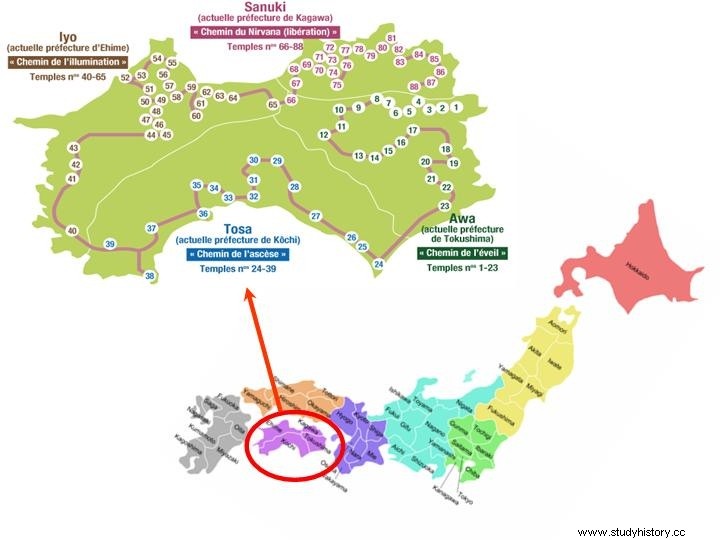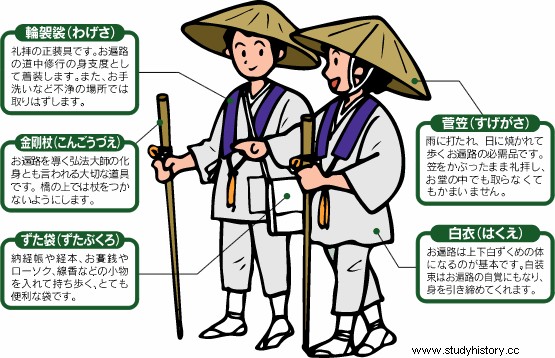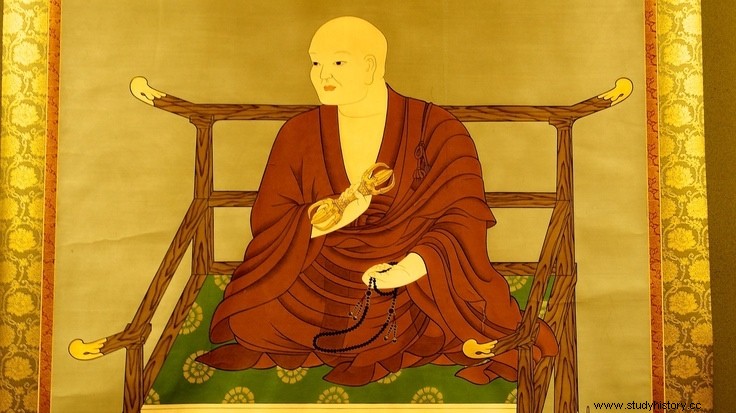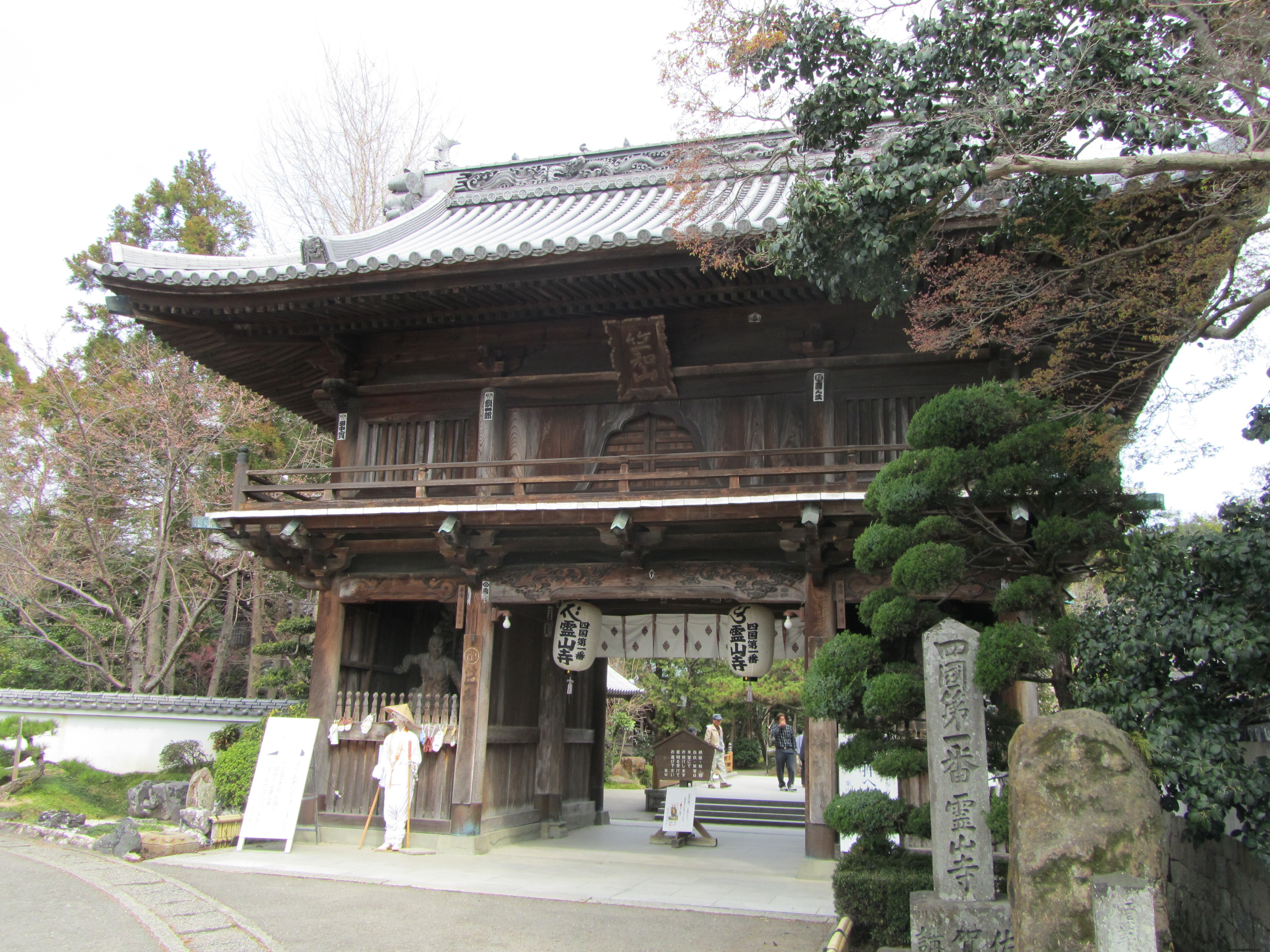The Japanese have a bad reputation for being copycats. Always appropriating other people's ideas or inventions and then modifying and improving them on your own. But that sambenito is quite unfair. For example, if we say that in Japan they have an indigenous version of the Camino de Santiago, there will be no shortage of people raising an eyebrow with a certain disdain. They even have to copy us!, he will think. Well, no, things are not always what they seem. That sacred route really exists, deep in rural Japan, but it is not, nor is it intended to be, an imitation. It has been there for many centuries, practically as many as the Jacobean route itself, and its history is equally interesting.

Shikoku Henro
The Shikoku Henro is a pilgrimage route that runs through 88 temples (mostly Buddhist) on the island of Shikoku , the smallest of the main islands that make up the Japanese archipelago. The route, which covers about 1,200 km, covers practically the entire perimeter of the island, and doing it on foot in the traditional way can take about 40 or 50 days, depending on how light on your legs you are. Pilgrims usually wear specific clothing to be recognized as such:a white tunic, a conical straw hat, and a wooden staff. It is typical for the locals to offer them alms, either in money or in the form of food, in exchange for a blessing. In addition to the 88 "official" temples, there are an additional 20 that can also be visited, which leaves the total number at a number that is most auspicious for Buddhist cosmology:108 .

Japanese pilgrims
Tradition associates this path with the monk Kukai , who is said to have been the first to circle the island from temple to temple, lost in his musings. As often happens with sacred routes around the world, there are a thousand and one stories about how and why it came about, almost all associated with the figure Kukai . Most of them are mere legends, but there are plenty of reasons to link the Shikoku Henro to the pilgrimages of this monk who lived between the 8th and 9th centuries.
Kukai was born in Shikoku itself in the year 774. Japan was at the end of the Nara period. , which in Japanese historiography is still considered the Ancient Age. The city of Kyoto hadn't even been founded yet, and it was a couple of centuries before the first samurai would churn copper on the battlefields. Kukai was the son of a noble family, and he was going to be a court official until the call of Buddha made him give up his studies and devote himself to asceticism and meditation. His parents must not have been very amused by that mystical flash, but, seen from a certain perspective, the truth is that it cannot be said that Kukai made a bad choice. His new monastic life would lead him to be one of the most revered sages in the history of Japan.
Kukai spent half his days wandering the mountains in spiritual retreat, and the other half studying the sutras in the libraries of the main temples in the country. The wild places of his native Shikoku were his favorite place to devote himself to contemplation. But this eccentric holy man did not go unnoticed in the centers of power in Nara, the old capital, and neither in Kyoto, the brand new imperial seat. Thus, he was chosen to be part of a diplomatic mission to China, an honor. Although, rather than get involved in politics, he took advantage of the trip to deepen his studies on esoteric Buddhism with local teachers. It is clear that this kind of Chinese Erasmus spread to him a lot because, when he came back, he used that knowledge to create a new Buddhist creed, the Shingon , which today is one of the main branches of Japanese Buddhism.

Kukai
Kukai was also a remarkable man of letters, to whom the Japanese language owes much. He is even credited with inventing hiragana alphabets. and katakana , which today, combined with Chinese characters, are the basis of Japanese writing. Probably the latter is just a legend, but it gives us an idea of the dimension that the figure of Kukai has in Japan. Upon his death in 835, following Buddhist custom, he was given the posthumous name of Kobo Daishi , for which he is also known. His grave on Mount Koya , south of Osaka, is one of the sacred sites par excellence in the country, a place of pilgrimage since time immemorial.
It is therefore not surprising that, by extension, the creation of the path of the 88 temples is also attributed to him. Kukai liked to make a pilgrimage to his native Shikoku whenever he had the chance, as it was a place away from the madding crowd and hustle and bustle of the court. From there is born the myth that attributes to him having traced the route that circumambulates the entire island. Of course, it is also said that he was the one who founded practically every single Buddhist temple in Shikoku. But, just as the custom of pilgrimage to Santiago probably predates the arrival of Christianity in the Iberian Peninsula, many of these temples, and the routes that link them, are older than Kukai itself.

Entrance to the Ryozenji temple, the first of the 88
We can say with certainty that the path of the 88 temples begins to be a recognized tradition at least since the middle of the 9th century. But the chronicles go back even further; as early as the 7th century, semi-legendary ascetics opened the first pilgrimage routes around Shikoku . Kukai probably simply limited himself to imitating them on his journeys around the island. After his death, a new generation of monks and mystics wanted to follow in his footsteps and, from there, the Henro it was expanding and growing, both in kilometers and in popularity.
But it would not reach its final form until the s. XVII, in the middle of the Edo era , with the Tokugawa shoguns ruling the newly unified Japan. That's when his fame skyrockets. With the country pacified after a century and a half of continuous internal wars, the roads were finally free of rustlers and thugs. Traveling was safe again, and it became a fashionable hobby. Pilgrimages to holy places, such as the Ise shrine or Izumo experienced a real boom, and the old routes, such as the Shikoku road , resurfaced from the oblivion to which the era of civil wars had condemned them. His popularity would remain intact to this day, unmoved by the future of world conflicts and revolutions.
The path of the 88 temples is not the only sacred route that exists in Japan, not even the oldest, but it is surely the most famous. Comparisons are odious, and it would be absurd to try to equate the Shikoku Henro with the Camino de Santiago. Historically and culturally, they are very different. But the Kukai route also has a thousand-year-old tradition that, in a certain way, runs parallel to that of the apostle who (supposedly) rests in Compostela.
Collaboration of R. Ibarzabal
Sources:Shikoku Henro Trail, Making Pilgrimages:Meaning and Practice in Shikoku –Ian Reader
